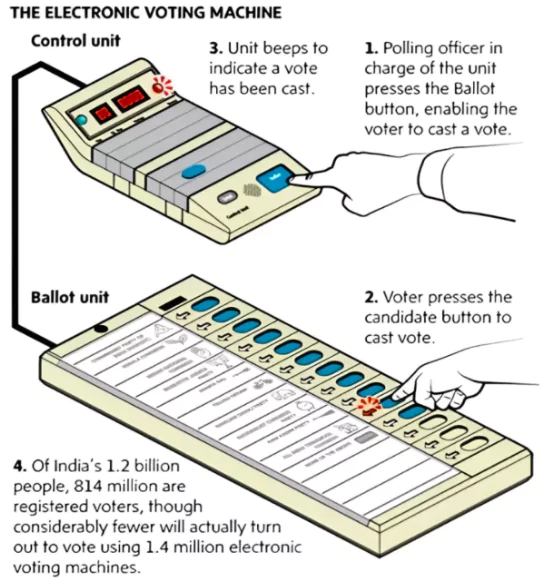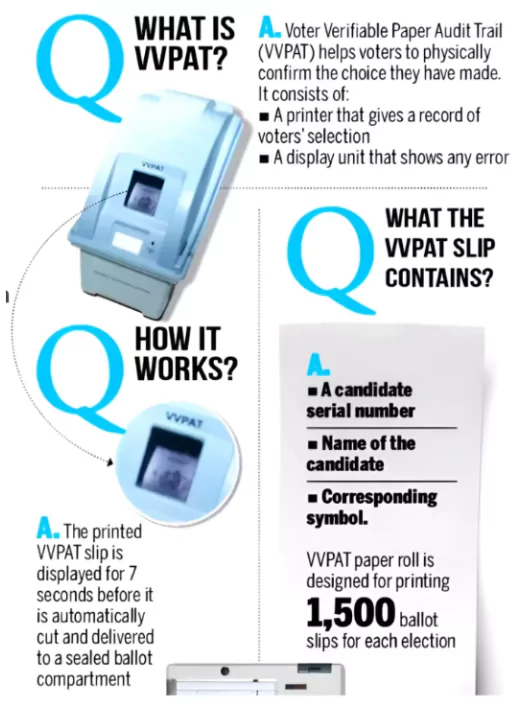For the first time, 11 candidates from the 2024 Lok Sabha and state Assembly elections have requested verification of the burnt memory in the Ballot Units (BUs), Control Units (CUs), and Voter Verified Paper Audit Trail (VVPAT) units of electronic voting machines (EVMs).
Enroll now for UPSC Online Course
Key Highlights Of The Supreme Court Order
| April 2024 Order Of The Supreme Court
Rejection to All Petitions:
- The Court refused to intervene against Section 49 MA of the Conduct of Election Rules.
- This section penalises a voter whose complaint of mismatch (of votes cast and votes counted) would attract penal proceedings initiated by poll officials under Section 177 of the Indian Penal Code for submitting false information.
- The Supreme Court also refused to direct the cross-verification of 100% EVMs and VVPATs across the country.
- Currently, only 5% of EVM-VVPAT counts are randomly verified in any given Assembly constituency.
Post-poll Checking:
- The burnt memory semicontroller in 5% of the EVMs that is the Control Unit, Ballot Unit and the VVPAT per assembly constituency per parliamentary constituency shall be checked and verified by a team of engineers after the declaration of results.
- The actual cost to be borne by the candidate making the request.
- Expenses to be refunded in case the EVMs are found to be tampered with.
|
- Provision: The Supreme Court allowed second- and third-placed candidates to seek verification of up to 5% of the burnt memory of EVMs and VVPATs in an Assembly constituency or segment of a Lok Sabha constituency.
- If both 2nd and 3rd placed candidates apply, each will be allowed to verify 2.5% of the EVMs and VVPATs.
- Requirements: Candidates must identify the EVMs to be verified
- Make requests within seven days of the result declaration
- Pay for verification costs, refundable if tampering is found.
- Deposit Rs 40,000 (plus GST of 18%) per set of EVM (BU, CU, and VVPAT) to the manufacturer concerned.
- The verification process begins 45 days after the result declaration to allow time for filing election petitions.
- If election petitions are filed, the verification will be delayed until court orders are received.
About Electronic Voting Machine (EVM)

- A Portable Instrument: An EVM Machine is a portable instrument for the purpose of conducting elections to the parliament, legislature and local bodies like panchayats and municipalities.
- Manufacturer: Bharat Electronics Ltd. (BEL), Bangalore, a Defence Ministry PSU, was elected along with ECIL to manufacture the EVM Machine.
- Comprises: An EVM Machine has three units
- A ballot unit
- A control unit – For the officer-in-charge to ensure a voter is able to vote only once
- A voter-verifiable-paper-audit-trail (VVPAT) unit – Which produces a paper slip that is visible to the voter via a transparent screen for about seven seconds before it gets stored in a sealed drop box.
- Controlled by: The control unit of the EVM is kept with the Presiding Officer and the balloting unit is kept within the voting compartment for electors to cast their votes.
- Legal Sanction: Section 61A was included in the Representation of the People Act 1951, empowering the ECI.
- Representation of People’s Act, 1951 (RPA): It governs the conduct of elections in India. It provides the grounds for disqualifying a person from contesting elections or holding the position of a people’s representative.
- Evolution:
- Trial-Run: The EVM Machine was introduced on a trial basis in 1982 in the Assembly constituency of Paravur in Kerala.
- Nationwide Deployment: They were deployed in all booths during the Assembly elections of Tamil Nadu, Kerala, Puducherry and West Bengal in 2001.
- In the 2004 general elections to the Lok Sabha, EVMs were used in all 543 constituencies.
- The 2019 elections had EVMs backed with 100% VVPAT in all constituencies.
- Ruling by Supreme Court: The SC in various judgments has upheld the validity of using EVMs in elections.
- In Subramanian Swamy versus Election Commission of India (2013), the Supreme Court ruled that a paper trail is an indispensable requirement for free and fair elections.
About Voter Verifiable Paper Audit Trail (VVPAT)

- An Independent System: It is an independent system that consists of two parts
- VVPAT Printer
- VVPAT Status Display Unit (VSDU)
- It is attached to the Electronic Voting Machines (EVMs), that allow the voters to verify that their votes are cast as intended.
- When a vote is cast, a slip is printed containing the serial number, name, and symbol of the candidate and remains exposed through a transparent window for 7 seconds.
- Came into Use: It was first used in the Noksen constituency in Nagaland in 2013 and used at an all India level in the 2019 Lok Sabha Elections.
- Accessed by: VVPAT machines can be accessed by polling officers only.
About Ballot Paper System
- A Traditional Method: It is the traditional mode of voting and widely used in manual or hand-counted voting systems.
- Manual Marking: Voters physically mark their choices on the paper ballot, typically by filling in circles or boxes next to the names of candidates or options.
- Collection & Counting: Once voters have marked their preferences, they deposit their completed ballots into designated ballot boxes.
- Subsequently, election officials manually count the ballots to determine the election outcome.
- Transparent Process: The visibility of the entire process, from marking the ballot to counting the votes, ensures transparency and instills confidence in the fairness of the electoral exercise.
|
Check Out UPSC Modules From PW Store
![]() 24 Jun 2024
24 Jun 2024
